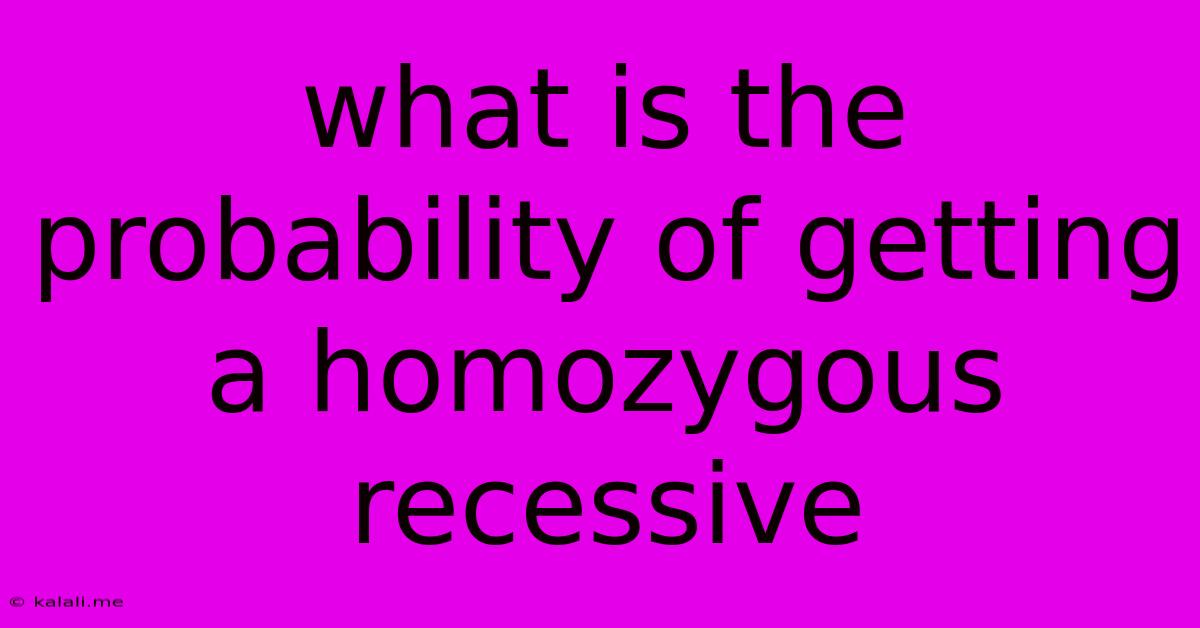What Is The Probability Of Getting A Homozygous Recessive
Kalali
May 09, 2025 · 3 min read

Table of Contents
What is the Probability of Getting a Homozygous Recessive Genotype? Understanding Mendelian Genetics and Punnett Squares
Understanding the probability of inheriting a homozygous recessive genotype is fundamental to grasping Mendelian genetics. This article will explore this concept, explaining the underlying principles and demonstrating how to calculate these probabilities using Punnett squares and other methods. We'll also delve into situations involving multiple genes and discuss the implications of these probabilities in real-world scenarios.
What is a Homozygous Recessive Genotype?
Before calculating probabilities, let's define our terms. A genotype refers to the genetic makeup of an organism, specifically the combination of alleles it possesses for a particular gene. An allele is a variant form of a gene. For many genes, two alleles exist: one dominant (represented by a capital letter, e.g., 'A') and one recessive (represented by a lowercase letter, e.g., 'a').
A homozygous recessive genotype means an individual possesses two copies of the recessive allele (aa). This is in contrast to a homozygous dominant genotype (AA) and a heterozygous genotype (Aa), where the dominant allele masks the expression of the recessive allele. Only when an individual is homozygous recessive will the recessive trait be visibly expressed (phenotype).
Calculating Probability Using Punnett Squares
Punnett squares are a visual tool used to predict the probability of different genotypes and phenotypes in offspring. Let's consider a simple monohybrid cross (involving one gene) where both parents are heterozygous (Aa).
| A | a | |
|---|---|---|
| A | AA | Aa |
| a | Aa | aa |
This Punnett square shows four possible genotype combinations for the offspring: AA, Aa, Aa, and aa. Therefore:
- The probability of a homozygous dominant offspring (AA) is 1/4 or 25%.
- The probability of a heterozygous offspring (Aa) is 2/4 or 50%.
- The probability of a homozygous recessive offspring (aa) is 1/4 or 25%.
Beyond Simple Monohybrid Crosses: Dihybrid and Trihybrid Crosses
The principles extend to more complex crosses involving multiple genes. For example, in a dihybrid cross (two genes), the probability of a homozygous recessive genotype for both genes becomes significantly lower. The complexity increases with trihybrid crosses and beyond, demanding more elaborate Punnett squares or alternative probability calculations. Understanding the independent assortment of genes is crucial for accurate prediction in these instances.
Factors Affecting Probability
Several factors can influence the probability of inheriting a homozygous recessive genotype:
- Parental Genotypes: The genotypes of the parents directly determine the possible combinations of alleles in the offspring, and thus influence the probability of a homozygous recessive genotype.
- Gene Frequency: The frequency of a particular allele within a population influences the probability of two individuals carrying the recessive allele and thus producing homozygous recessive offspring. This concept plays a critical role in population genetics.
- Genetic Linkage: If genes are located close together on the same chromosome (linked genes), they are less likely to undergo independent assortment during meiosis, affecting the predicted probabilities based on simple Mendelian inheritance.
Real-World Implications
Understanding the probability of inheriting homozygous recessive genotypes is vital in various fields:
- Genetic Counseling: Predicting the risk of inherited diseases, many of which are caused by recessive alleles, is essential for providing informed genetic counseling.
- Agriculture: Breeders utilize knowledge of inheritance patterns to select parents with desirable traits, including those associated with recessive alleles.
- Evolutionary Biology: The frequency of recessive alleles within a population and their impact on survival and reproduction are essential aspects of evolutionary studies.
Conclusion:
The probability of inheriting a homozygous recessive genotype is a key concept in genetics, readily calculated using Punnett squares for simple crosses. However, the complexity increases with multiple genes, requiring a deeper understanding of genetic principles and more sophisticated analytical tools. Understanding these probabilities is not only academically important but also holds significant implications for various fields, influencing decision-making in areas like genetic counseling, agriculture, and evolutionary biology.
Latest Posts
Latest Posts
-
Convert 3 20 To A Decimal
May 10, 2025
-
How To Write 10 As A Fraction
May 10, 2025
-
What Is The Square Root Of 8100
May 10, 2025
-
How To Find Surface Area With A Net
May 10, 2025
-
What Is 11 Out Of 18
May 10, 2025
Related Post
Thank you for visiting our website which covers about What Is The Probability Of Getting A Homozygous Recessive . We hope the information provided has been useful to you. Feel free to contact us if you have any questions or need further assistance. See you next time and don't miss to bookmark.